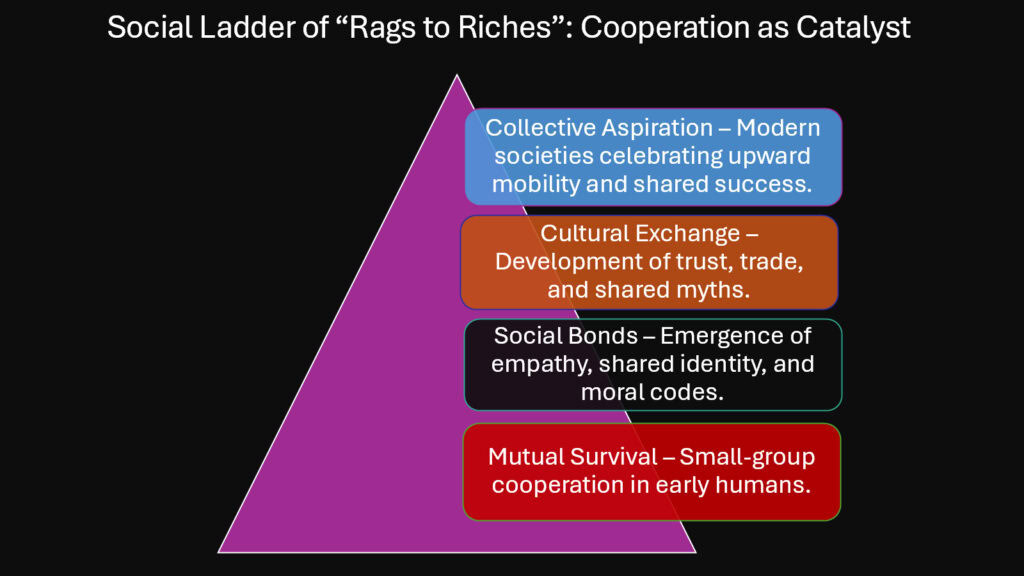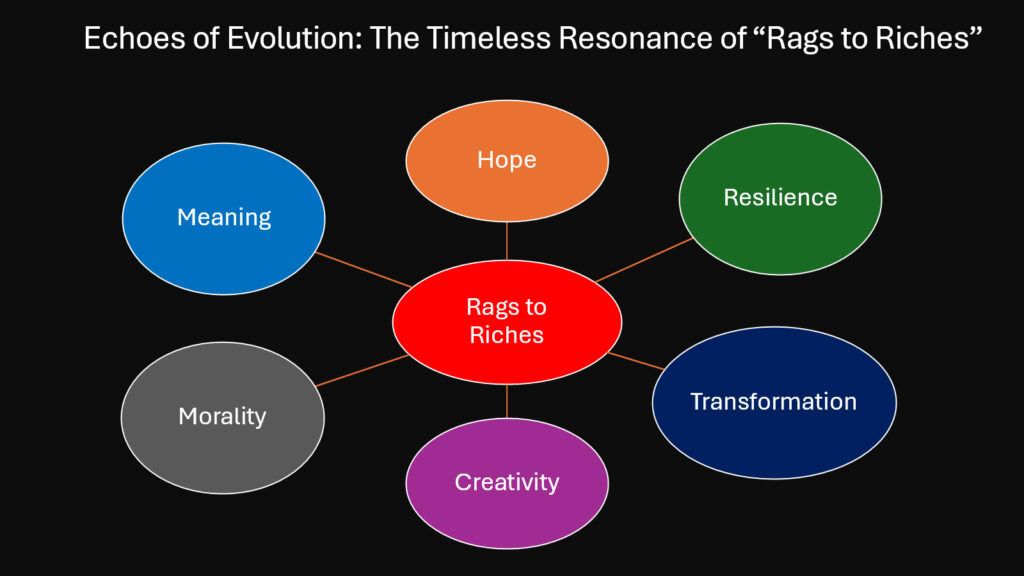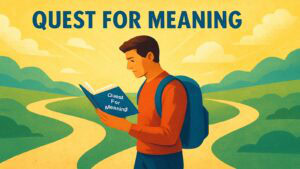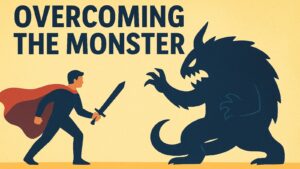Table of Contents
Introduction: The Rags to Riches Story as Humanity’s Mirror

A child sleeps on cold stone, stomach empty, dreaming of warmth. Centuries later, an entrepreneur wakes in a small apartment, dreaming of empire. Between these moments lies the most enduring pattern in human storytelling. The Rags to Riches archetype speaks to something deeper than ambition or luck. It whispers of an ancient promise coded into our very bones.
When our ancestors first stood upright on African savannas, they carried nothing but hunger and hope. Every sunrise was a gamble against extinction. From those desperate beginnings, humanity built civilizations, philosophies, and dreams that reach beyond the stars. The Rags to Riches story does not merely celebrate success. It remembers that journey from scarcity to possibility, from fear to self-awareness.
This archetype pulses through mythology, literature, and film because it mirrors our species’ own evolutionary arc. We began as creatures driven purely by survival instinct. Over millennia, we transformed those base drives into something transcendent: the pursuit of meaning, legacy, and self-actualization. The Rags to Riches narrative captures this transformation in miniature, compressing millions of years of human development into a single hero’s journey from deprivation to fulfillment.
Understanding this archetype means understanding ourselves. The desire to rise, to overcome, to transform limitation into abundance is not merely cultural. It is biological memory speaking through a narrative hook. When we respond emotionally to a Rags to Riches story, we are recognizing our own species reflected back at us.
This article explores six evolutionary lessons encoded within the Rags to Riches archetype. From primal survival instincts to the psychology of cooperation, from archetypal transformation to the evolution of aspiration itself, these lessons show why this story pattern continues to captivate audiences across every culture and era.
Comparing Rags to Riches with Other Story Archetypes
| Story Archetypes | Core Evolutionary Reflection |
|---|---|
| Rags to Riches | Journey from survival scarcity to self-actualization and abundance, mirroring humanity’s evolutionary ascent from basic needs to complex aspirations |
| Overcoming the Monster | Confrontation with external threats that once endangered early human existence, representing collective triumph over predators and environmental dangers |
| Quest For Meaning | Search for purpose beyond survival, reflecting the development of consciousness and humanity’s transition from instinctive living to philosophical inquiry |
| Voyage and Return | Exploration and safe homecoming, echoing human migration patterns and the courage required to venture into unknown territories for resources |
| Power of Connection | Emphasis on relationships and community bonds that enabled early humans to survive through cooperation rather than individual strength alone |
| Rebirth and Revelation | Transformation of identity and perspective, representing cognitive leaps in human evolution from simple awareness to self-reflection and renewal |
1. Rags to Riches and the Instinct to Survive
The opening chapter of every Rags to Riches story begins in deprivation. The hero lacks food, shelter, safety, or dignity. This narrative starting point activates something primal within us, a recognition that predates language itself. Our earliest ancestors understood hunger not as metaphor but as existential threat. Every Rags to Riches tale begins where humanity itself began: on the razor edge between survival and extinction.
For millions of years, our ancestors woke each day facing immediate physical challenges. Finding food, avoiding predators, securing shelter from elements that could kill within hours. The human brain evolved not for philosophy but for survival. Fear became our teacher. Hunger drove innovation. The instinct to persist became hardwired into our neural architecture.
This survival imperative created emotional templates that still govern our responses today. When we encounter a Rags to Riches protagonist struggling with poverty, we are not simply observing fictional hardship. We are recognizing ancestral memory. The desperation of a character scraping together coins for bread echoes the desperation of a hunter returning empty-handed to a starving tribe.
Psychologist Abraham Maslow described this as a hierarchy of needs, with physiological requirements forming the foundation upon which all higher aspirations rest. But Maslow was describing something evolution had already encoded into storytelling patterns millennia before psychology existed as a discipline.
What makes the Rags to Riches archetype emotionally powerful is how it transforms survival desperation into motivation for growth. The hero does not simply want to survive. They want to transcend their circumstances. This reflects a distinctly human capacity: the ability to look beyond immediate threat and imagine a better future.
The foundation of every upward journey in this archetype rests on survival instinct. Without that primal drive to persist against overwhelming odds, there would be no story. The hero’s determination mirrors humanity’s own stubborn refusal to accept extinction.
Survival Imperatives Reflected in Narrative Structure
| Evolutionary Survival Need | Rags to Riches Narrative Element |
|---|---|
| Securing food and nourishment | Hero begins in material poverty, often hungry or malnourished, establishing baseline vulnerability |
| Finding safe shelter | Protagonist lacks stable housing or lives in dangerous environments, creating urgency |
| Avoiding physical threats | Early scenes establish dangers the hero faces, activating protective instincts in audience |
| Forming protective relationships | Hero seeks allies or mentors who can provide safety and resources for survival |
| Developing resourcefulness | Protagonist must innovate and adapt using limited means, mirroring ancestral problem-solving |
| Maintaining hope despite desperation | Hero’s persistent optimism reflects human capacity to imagine better futures even under dire conditions |
2. Rags to Riches and the Power of Adaptation

Survival alone cannot explain the Rags to Riches archetype. The second phase involves transformation through adaptation. The hero must change, learn, and develop new capabilities to progress. This mirrors one of evolution’s central mechanisms: the power of adaptation to bridge the gap between survival and flourishing.
Human evolutionary history is a chronicle of remarkable adaptability. When climate changed and forests receded, our ancestors adapted to savanna life. Early humans migrated across continents, adapting to deserts, mountains, frozen tundras, and tropical islands. Those who could not adapt perished. Those who could flourished and passed their flexible thinking to descendants.
The development of tools represents one of humanity’s most significant adaptive achievements. A rock becomes a hammer. A sharp stone becomes a blade. This capacity to see beyond an object’s immediate form and imagine its potential transformed human capabilities. This same mental flexibility appears in Rags to Riches protagonists who must improvise solutions using whatever limited resources they possess.
Psychological adaptation proved equally crucial. Early humans who could read social cues, anticipate others’ needs, and adjust their behavior accordingly gained advantages in group settings. The capacity for psychological flexibility became as important as physical adaptation.
Migration illustrates adaptation at its most dramatic. Leaving familiar territories meant encountering unknown dangers, new climates, and unfamiliar food sources. Success required mental plasticity. This willingness to leave the known for the unknown echoes through every Rags to Riches narrative where the hero ventures beyond their limited circumstances.
Classic Rags to Riches heroes embody this adaptability. They begin rigid, limited by inexperience and circumstance. Through trials, they develop flexibility. They learn new skills, adopt different perspectives, and discover inner resources they did not know they possessed.
Evolutionary Adaptation Mechanisms in Storytelling
| Adaptive Evolutionary Development | Rags to Riches Story Parallel |
|---|---|
| Tool creation and innovation | Hero learns practical skills or discovers creative uses for available resources |
| Migration to new environments | Protagonist leaves familiar circumstances and adapts to unfamiliar social or physical settings |
| Social learning and mentorship | Hero observes others and incorporates successful strategies into personal approach |
| Trial and error problem solving | Character faces repeated failures but adjusts tactics based on experience |
| Cognitive flexibility development | Hero shifts perspective or worldview when old beliefs prove limiting or false |
| Cross-domain skill transfer | Protagonist applies knowledge from one area to solve problems in another domain |
3. Rags to Riches Through the Hero’s Journey
Joseph Campbell spent decades studying mythology across cultures and discovered something extraordinary. Despite vast differences in setting and characters, certain narrative patterns appeared repeatedly. Campbell called this universal story structure the monomyth or the Hero’s Journey. The Rags to Riches archetype fits naturally within this framework, revealing that success stories follow the same psychological script as ancient myths.
Campbell identified several key stages. The hero begins in an ordinary world, receives a call to adventure, initially refuses that call, meets a mentor, crosses a threshold into the special world, faces tests and trials, experiences transformation, and finally returns changed. These stages describe external plot movements but represent internal psychological developments.
Consider how the Rags to Riches archetype maps onto the hero’s quest. The hero starts in poverty, representing the ordinary world. Something disturbs this equilibrium. Often the hero hesitates, doubting their capacity for change. A mentor appears, offering guidance. The hero commits to transformation, crossing from their known world into the challenging realm of ambition and risk.
The middle phase involves trials that test resolve, adaptability, and character. Ancient myths featured literal monsters. Modern Rags to Riches stories substitute business competitors, social prejudice, or internal demons. The function remains identical. Through struggle, the hero discovers capabilities they did not know they possessed.
Campbell argued that these patterns resonate because they reflect universal human psychological processes. The journey from limitation to capability represents developmental stages every person navigates. When we watch a Rags to Riches protagonist overcome obstacles, we are witnessing an externalized version of our own internal struggles toward maturity.
This explains why ancient myths and modern success stories form similar emotional arcs despite surface differences. Both narratives describe transformation through ordeal. Both celebrate human capacity for growth. The Rags to Riches story is not simply about material success but about psychological evolution.
Campbell’s Hero’s Journey Stages in Rags to Riches
| Hero’s Journey Stage | Rags to Riches Expression |
|---|---|
| Ordinary World | Hero lives in poverty or limitation with no clear path forward |
| Call to Adventure | Opportunity appears or necessity demands the hero seek better circumstances |
| Refusal of the Call | Hero doubts their capability or fears the risks of attempting transformation |
| Meeting the Mentor | A guide or role model appears offering wisdom, skills, or inspiration |
| Crossing the Threshold | Hero commits to change and enters the challenging world of ambition and risk |
| Tests and Trials | Character faces obstacles testing resolve, adaptability, and emerging capabilities |
4. Rags to Riches and the Rise of Cooperation

Evolution often gets simplified into a story about competition. Survival of the fittest becomes shorthand for ruthless individualism. But this misreads evolutionary history profoundly. Humanity’s greatest adaptive advantage was not individual strength but our capacity for cooperation. The Rags to Riches archetype celebrates not solitary achievement but the power of collective effort.
Early humans were not impressive physical specimens. We lacked the claws of predators, the speed of hunters. What we possessed was the ability to work together toward shared goals. A single human could not bring down a mammoth. A coordinated group with shared strategies could. Cooperation transformed vulnerability into strength.
This collaborative imperative shaped human psychology in fundamental ways. We evolved to read facial expressions, interpret tone of voice, and respond to emotional states in others. Empathy was not a luxury but a survival tool. Understanding what others needed made cooperation possible. Those who could form strong social bonds had better access to resources and protection.
Language emerged as a technology for cooperation. Words allowed humans to share knowledge across time and space. One person’s discovery became the entire group’s advantage. Stories transmitted survival strategies across generations. Language made possible the elaborate coordination that characterized successful human communities.
The Rags to Riches archetype often features mentors, allies, and communities that enable the hero’s rise. These supporting characters are not narrative conveniences but essential elements reflecting cooperation’s central role in human success. The lone genius who achieves everything through individual effort is a myth. Real achievement depends on networks of mutual support.
This collective dimension gives the Rags to Riches archetype its moral framing. Heroes who rise by helping others create more emotionally satisfying narratives than those who succeed through pure selfishness. We respond positively to stories celebrating cooperation because our evolutionary history taught us that mutual aid benefits everyone.
Cooperative Evolution and Narrative Community
| Evolutionary Cooperative Trait | Rags to Riches Community Element |
|---|---|
| Empathy and emotional reading | Hero forms genuine connections with others and understands their needs and perspectives |
| Knowledge and skill sharing | Mentors teach protagonist essential capabilities they could not develop alone |
| Resource pooling and distribution | Supporting characters provide material help, access, or opportunities during hero’s journey |
| Collective defense and protection | Allies offer safety or defend hero from threats during vulnerable transformation phases |
| Language and communication | Hero learns to express ideas clearly and persuade others to support their vision |
| Reciprocal altruism patterns | Protagonist helps others and later receives help in return, creating mutual support networks |
5. Rags to Riches Through the Lens of Archetypal Psychology
Carl Jung proposed that certain images, characters, and patterns appear across human cultures because they emerge from what he called the collective unconscious. These archetypes represent universal human experiences and psychological processes. The Rags to Riches story, viewed through Jungian psychology, becomes more than a narrative about external success. It represents the journey toward psychological wholeness that Jung called individuation.
Jung identified the hero archetype as one of the most powerful universal patterns in human psychology. The hero represents the ego’s journey toward integration with the Self, that larger totality of conscious and unconscious elements that constitute complete personhood. This journey requires confronting shadow aspects of personality and achieving balance between opposing forces within consciousness.
In Rags to Riches narratives, the initial poverty represents more than material deprivation. It symbolizes psychological incompleteness. The hero begins fragmented, defined by what they lack. This mirrors the state Jung described as identification with a limited aspect of self. The journey upward becomes a process of recovering undeveloped parts of personality.
The trials and challenges serve psychological functions. They force the hero to confront fears, limitations, and false beliefs. Each obstacle reveals another aspect of personality that must be acknowledged and integrated. The antagonists often represent externalized versions of internal conflicts.
Jung emphasized that individuation requires accepting both light and shadow aspects of personality. The successful Rags to Riches hero does not achieve perfection but authenticity. They learn to accept their flaws while developing their strengths. This balanced integration mirrors humanity’s evolutionary journey from simple instinct-driven behavior to complex self-reflective consciousness.
The ultimate reward, from a Jungian perspective, is not wealth but self-knowledge. The hero who completes the journey understands who they truly are. This reflects humanity’s larger evolutionary arc from purely unconscious existence to increasing self-awareness and introspection.
Jungian Archetypal Elements in Rags to Riches
| Jungian Concept | Rags to Riches Psychological Expression |
|---|---|
| Hero Archetype | Protagonist represents ego striving toward integration with the complete Self |
| Shadow Integration | Hero confronts rejected or hidden aspects of personality through challenges and failures |
| Persona Development | Character learns to present authentic self rather than false masks to gain social acceptance |
| Individuation Journey | Entire narrative arc represents process of becoming psychologically whole and self-actualized |
| Anima and Animus | Supporting characters may represent contrasexual aspects of psyche requiring integration |
| Self Realization | Final achievement represents not just external success but internal psychological completeness |
6. Rags to Riches and the Evolution of Aspiration
Human desires have undergone a remarkable transformation over evolutionary time. Our earliest ancestors aspired simply to survive the next winter. Modern humans aspire to meaningful careers, artistic expression, and leaving lasting legacies. This evolution of aspiration parallels the development of the Rags to Riches archetype, which continues adapting to reflect changing definitions of success.
Initially, human goals centered on immediate physical needs. Food, shelter, safety, and reproduction consumed all available energy. Success meant staying alive long enough to pass genes to the next generation. The oldest versions of Rags to Riches stories reflect this focus on material survival and physical security.
As societies developed surplus resources, human aspiration expanded beyond mere survival. People could afford to pursue goals not directly related to immediate physical needs. Artistry, spirituality, philosophy, and abstract knowledge became possible. Humans began asking not just how to survive but why survival mattered. The Rags to Riches archetype evolved to incorporate themes of meaning and fulfillment alongside material success.
The development of complex social structures created new categories of aspiration. Status, reputation, and social standing became goals worth pursuing. Humans evolved to care deeply about how others perceived them because social acceptance determined access to resources. The Rags to Riches narrative has evolved and adapted, showing heroes not just gaining wealth but earning respect and recognition.
Modern versions often emphasize self-actualization over material accumulation. Contemporary audiences respond to heroes seeking authenticity, creative expression, or personal growth. This reflects an evolutionary trajectory where basic needs are met for larger portions of humanity, allowing focus to shift toward higher-order goals.
Storytelling itself drives this evolution. Each generation reimagines the Rags to Riches archetype to reflect contemporary values. The archetype persists because it remains flexible, continuously updated to match cultural conceptions of achievement while maintaining core patterns that resonate with our evolutionary inheritance.
Evolution of Human Aspiration in Narrative Form
| Aspirational Developmental Stage | Rags to Riches Thematic Focus |
|---|---|
| Basic survival needs | Early versions emphasize gaining food, shelter, and physical security |
| Material accumulation | Stories celebrate acquisition of wealth, property, and economic stability |
| Social status achievement | Narratives focus on gaining respect, recognition, and elevated social position |
| Purpose and meaning pursuit | Modern versions explore finding personally significant work or calling |
| Creative and intellectual expression | Contemporary stories feature heroes achieving artistic or innovative breakthroughs |
| Legacy and lasting impact | Recent iterations emphasize contributions that outlive the individual hero |
Conclusion: The Eternal Echo of the Rags to Riches Evolution

The Rags to Riches archetype endures because it tells a true story. Not true in the sense of historical accuracy, but true in a deeper way. It captures humanity’s actual journey from desperate scarcity to the possibility of abundance, from reactive survival to proactive creation of meaning. Every Rags to Riches tale echoes our species’ own remarkable transformation across millions of years of evolution.
The six evolutionary lessons explored in this article reveal the archetype’s profound connection to human development. Survival instinct provides the foundation, the primal drive that initiates every upward journey. Adaptation offers the mechanism, the flexibility that allows movement from one state to another. The Hero’s Journey framework shows how transformation follows universal psychological patterns. Cooperation demonstrates that human success has always been collective. Archetypal psychology reveals how external rise mirrors internal integration. The evolution of aspiration traces how human desires expanded from basic needs to transcendent goals.
These lessons interweave, each building upon the others. The Rags to Riches archetype succeeds not despite its simplicity but because of it. It distills complex evolutionary processes into emotionally accessible narrative form.
This archetype continues inspiring across ages and cultures because it reflects something universal about the human experience. Regardless of when or where we live, we all begin in limitation. We all face challenges that seem insurmountable. We all possess the capacity for growth, change, and transcendence. The Rags to Riches story reminds us that transformation is possible, that current circumstances need not determine ultimate outcomes.
Perhaps most importantly, the archetype connects us to our evolutionary heritage. We are the descendants of survivors who refused to accept defeat. Every time we respond emotionally to a Rags to Riches story, we are acknowledging this inheritance. We are recognizing ourselves in the hero’s struggle and triumph.
The Rags to Riches narrative is not just entertainment or wish fulfillment. It is humanity’s ongoing conversation with itself about what we were, what we are, and what we might become. It celebrates our journey from the edge of extinction to the threshold of the stars. In this sense, the archetype represents more than a story pattern. It is evolution itself, telling us who we are.
Core Insights from the Evolutionary Rags to Riches Journey
| Key Evolutionary Insight | Application to Understanding the Archetype |
|---|---|
| Survival instinct as narrative foundation | The archetype begins in deprivation because all human journeys begin with securing basic existence |
| Adaptation as mechanism for transformation | Hero’s flexibility and resilience mirror biological evolution’s central process of change |
| Universal psychological patterns | Story structure reflects deep cognitive scripts for human growth and development |
| Cooperation as success multiplier | Supporting characters represent our species’ greatest adaptive advantage through mutual aid |
| Inner journey toward wholeness | External rise symbolizes internal psychological integration and self-realization |
| Expanding definition of achievement | Archetype evolves alongside humanity’s growing capacity for abstract and meaningful goals |




